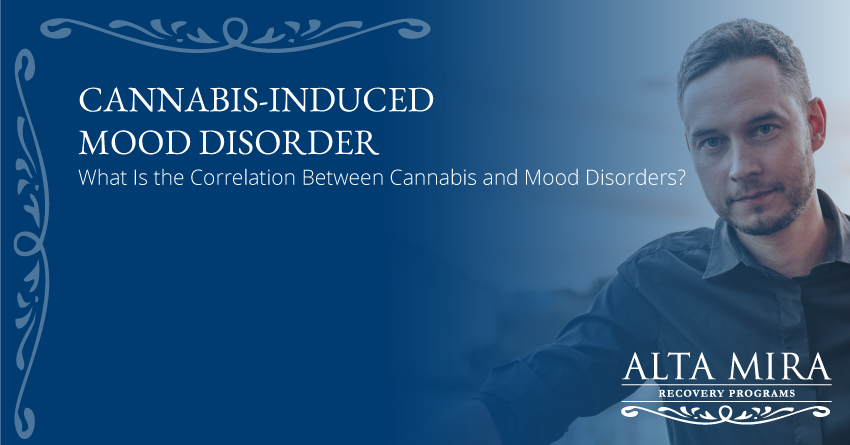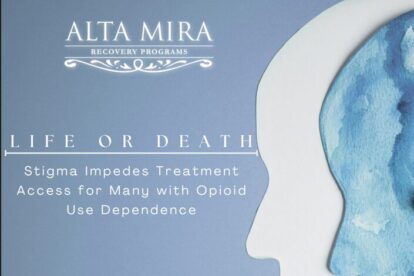Cannabis-Induced Mood Disorder: Does Use Lead to Mental Anguish?

Given its widespread availability, it is understandable that cannabis has become one of the most commonly used substances in the United States. In California, there were over 1,000 recreational and medicinal retailers for cannabis in 2020. This makes access to cannabis easier than ever before.
But what about the negative effects of cannabis? There haven’t been any really discussed in the past, so why now are people getting cannabis-induced mood disorders? What has changed?
Alta Mira’s team of experts specialize in substance use disorders and co-occurring mental health conditions. In this report, cannabis-induced mood disorders will be discussed along with identification and treatment options.
What Is the Correlation Between Cannabis and Mood Disorders?
In recent years, cannabis has emerged as a prominent topic of debate, particularly as a growing number of states have legalized its use for recreational purposes. While cannabis is recognized for its potential medical benefits, there is evidence suggesting a connection between chronic cannabis use and the onset of mood disorders, such as depression and bipolar disorder.
Numerous studies have been conducted to investigate the relationship between cannabis use, the development of cannabis use disorder, and the sequential occurrence of depression. Although the findings are somewhat mixed, a pronounced body of evidence indicates that prolonged cannabis use may be associated with the development or exacerbation of pre-existing mood disorders. This showcases the importance of further research to clarify these associations and guide clinical interventions.
The Impact of Cannabis and the Development of Mood Disorders
Mood disorders are mental health conditions that significantly influence how individuals respond to life events and stressors. Those without a mood disorder have reactions to challenging or negative experiences that involve balanced, rational emotions and thoughts. Individuals with mood disorders respond differently, often experiencing prolonged feelings of depression, irritability, or difficulties with motivation and focus.
Major Depressive Disorder (MDD)
Major depressive disorder (MDD) is characterized by prolonged periods of intense low mood lasting for weeks. Individuals with MDD lose interest in previously enjoyable activities and have a loss of motivation. Sleep patterns become irregular, with individuals experiencing either excessive sleep or insomnia. Changes in eating habits are also common, leading to unintended weight gain or loss. As the most severe form of depression, MDD requires continuous monitoring and, in many cases, pharmacological intervention.
Chronic cannabis use has been associated with the exacerbation of existing depression. The increasing legality and accessibility of cannabis have led to higher consumption rates, particularly among teens and young adults. Simultaneously, the availability of more potent marijuana products from dispensaries has been linked to psychiatric disturbances in this demographic. Given that depression often manifests during adolescence and early adulthood, the interplay between potent cannabis use and the development of depression warrants careful consideration and further research.
Bipolar Disorder (BD)
Bipolar disorder is a mood disorder characterized by significant variations in mood, ranging from elevated states of mania to periods of deep depression. During manic episodes, individuals experience heightened mood and increased productivity, which has the probability of escalating to psychosis, particularly in those with bipolar I disorder. Effective management of bipolar disorder is crucial to mitigate the risk of severe manifestations.
In contrast, Bipolar II Disorder is associated with hypomania, a milder form of mania that is less severe and shorter in duration compared to the mania seen in Bipolar I Disorder. Individuals with Bipolar II Disorder are more commonly affected by depressive episodes, which can be prolonged and significantly impair daily functioning. While Bipolar I Disorder also includes depressive episodes, these may be less enduring and can occur concurrently with manic episodes.
A longitudinal study spanning 20 years investigated the correlation between cannabis use and the subsequent diagnosis of bipolar disorder or schizophrenia. The study found that 47% of participants who used cannabis developed bipolar disorder or schizophrenia, with the majority of cases emerging within 3 to 4.5 years of cannabis use. The significant prevalence of cannabis-induced mood disorders highlights the need for careful consideration of the long-term mental health impacts of cannabis use.

Symptoms and Diagnosis: Identifying Cannabis-Induced Mood Disorders
Determining the cause of a cannabis-induced mood disorder involves extensive patient history. The similarities between presenting clinical features of cannabis-induced psychiatric disorders (CIPD) and primary psychoses with parallel cannabis use have hindered diagnostic and management techniques. Many studies compare the two situations instead of distinguishing their key differences.
A recent study monitored patients who met the criteria of being over the age of 18, having had at least one psychotic episode, and having consumed cannabis in the last 30 days. Procedures included:
- Psychopathological assessment: Utilizing the Symptom Checklist-90-R – a 90-item self-report system used to measure current symptoms.
- The Scale to Assess Unawareness of Mental Disorders (SUMD): This tool evaluated the patient’s insight into their mental health condition. Two key scores were assessed:
- Unawareness of symptoms: Evaluating whether the patient acknowledged the existence of psychotic symptoms.
- “Misattribution” of symptoms: Assessing whether the patient recognized that their symptoms were related to a mental health condition or cannabis use. Full credit was given to patients who correctly attributed their symptoms to either mental illness or cannabis consumption.
- Psychiatric Research Interview for Substance and Mental Disorders (PRISM): These interviews were conducted after the patients were clinically stable, occurring within the first 10 days of inpatient treatment, and then again at 6-month follow-up visits. Initial diagnoses were compared to follow-up results. CIPD was diagnosed in cases where psychotic symptoms developed after cannabis use, symptoms subsided within the first months of treatment, and antipsychotic medications had been discontinued by the 6-month follow-up.
Of the 154 patients in the study, 50 were diagnosed with CIPD while the remaining 104 were diagnosed with a primary psychotic disorder. While schizophrenia was most prominent, bipolar disorder was the second highest diagnosis, showing the prevalence of cannabis not only in psychotic disorders but mood disorders as well.
Begin Your Recovery Journey Today
866-922-1350Psychosis and Cannabis-Induced Mood Disorder
Cannabis-induced psychosis has been linked to the worsening of mood disorders. A study highlighted the relationship between stopping cannabis use and relapse with psychiatric disorders. Over half the participants who relapsed with non-affective psychosis progressed to a psychiatric disorder. Meanwhile, only 7.7% who relapsed with affective psychosis developed a psychiatric disorder. Those who abstained from cannabis use after the first psychotic episode experienced no further psychiatric distress.
Additional Psychiatric Concerns Associated with Cannabis Use
Although cannabis use has become more widely accepted due to its legalization, it leads to significant problems in an individual’s life when it transitions into CUD. Cannabis use disorder occurs when cannabis consumption becomes disruptive and prioritized over essential aspects of life, such as work and relationships. Individuals with CUD experience intense cravings for cannabis, which dominate their thoughts and fuel compulsive use. Over time, these patterns result in financial difficulties and strained or lost relationships, leaving the individual in a state of disarray.
When cannabis use begins during adolescence, it disrupts normal brain development. Marijuana affects areas of the brain responsible for memory, cognition, and learning. During the teenage years, the brain is still forming critical connections between these regions, which are essential for healthy cognitive function. Cannabis interferes with these developmental processes, both in the short term and long term, potentially leading to permanent brain damage and impaired functioning.

Get Help for Marijuana Addiction Today in Sausalito, CA
Proactive intervention is essential to address cannabis-induced mood disorders before they impact patients further. Marijuana rehab represents a crucial initial step toward restoring physical and mental well-being. Alta Mira’s comprehensive program includes guided therapies, alternative counseling, and wellness coaching, all designed to support patients in transitioning to a marijuana-free lifestyle. Additionally, the development of coping skills is integral to managing stress and fostering healthy, sustainable methods of internal healing.
If you have a patient who is managing a cannabis use disorder, mental health condition, or both, Alta Mira has treatment options available. Our experts are leaders in addiction medicine, with many backgrounds and specialties they bring to the table. Addiction treatment is not one-size-fits-all, and our dedicated team will treat patients as individuals, with the tailored care they deserve. Call us today at 866-922-1350 to learn more about our program offerings.
Alta Mira: Science-backed treatment, world-class care.






